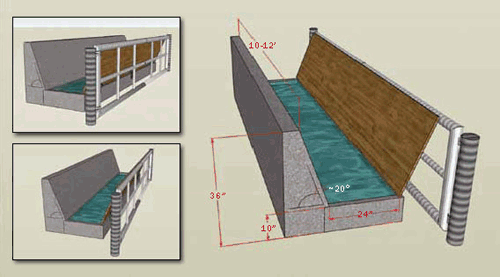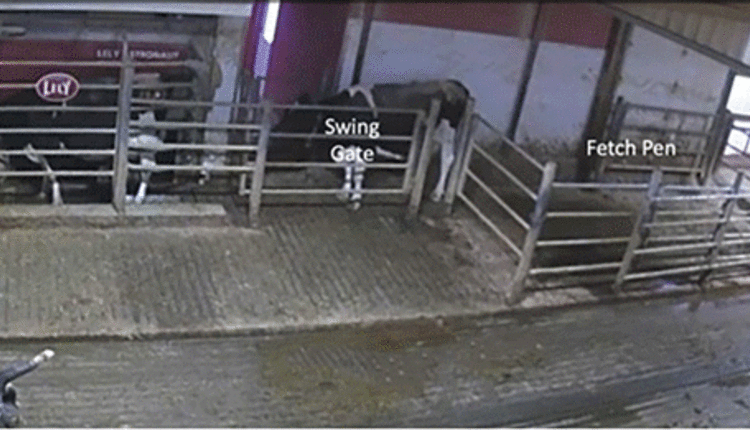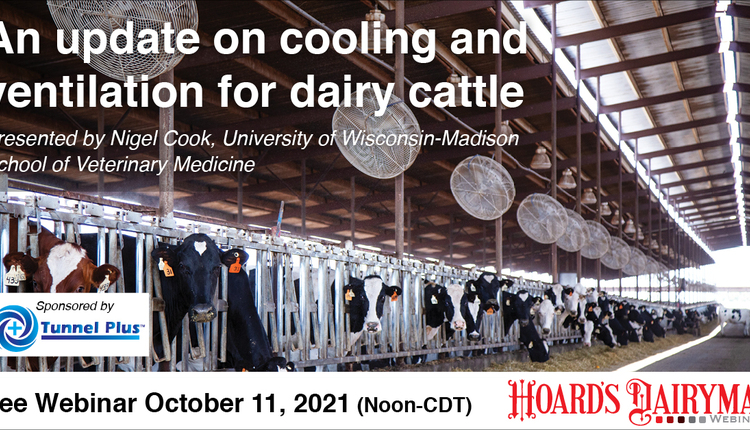The author is a clinical assistant professor with the School of Veterinary Medicine at the University of Wisconsin-Madison.

The new footbath model recommends a 10- to 12-foot length, 10-inch depth, 24-inch width, and one removable sidewall. Both sidewalls should be angled in, starting at about 3 feet above the floor of the bath. If not angled, a wider sidewall distance may be required.
Recently completed research suggests a deeper and longer bath keeps solution in and your money out. It also concludes that the prebath of water theory should be disregarded.
Footbath protocols are an integral component of infectious hoof disease control in free stall systems. Topical application of antibacterials such as copper sulfate, formalin, zinc compounds, and other disinfectants have been shown to aid the control of foot rot and digital dermatitis (heel warts). The footbath is a simple mechanism for treating large numbers of cattle quickly and efficiently.
Therefore, it is perhaps surprising that there is very little sound, scientific information on optimal hoof bath design. A common design is for the treatment bath to be preceded by a wash bath full of water and for each bath to contain about 50 gallons (190 liters) of solution. Baths are commonly 6 inches (15 cm) deep, 77 inches (1.9 m) long, and 36 inches wide (0.9 m). They are often located on sloped return lanes from the parlor, either side of the holding area. However, the reasons for this design have been lost over the course of time, so perhaps now is the time to question dogma and develop new guidelines, based on sound, scientific advice.
Should I use a water bath?
Proponents of putting a water (wash) bath in front of the treatment bath claim that they stimulate defecation in the prebath. They insist that this leaves the treatment bath cleaner and that water baths clean the foot before it enters the treatment bath.
We have collected data from three farms with water and treatment bath combinations. On all three farms, more cows defecated in the treatment bath than the wash bath, 8.5 percent versus 5.8 percent of cows, respectively. Wash baths do not keep the treatment bath cleaner!
It is also hard to believe that a single immersion in water significantly cleans off the cow's foot before it enters the treatment bath. If we are serious about cleaning off feet, several days of bathing with a surfactant such as liquid hand soap or rock salt would probably be more effective. For that, a single bath will suffice.
Use of a water bath has two other significant problems. First, when they are located immediately adjacent to the treatment bath, the water from the wash bath is transferred to the treatment bath. This dilutes the antibacterial being used as the cows pass through the baths, potentially reducing efficacy.
Second, use of a water bath adds a significant amount of water volume to the manure lagoon over the course of a year. For example, a 1,000- cow dairy using a 50-gallon (190 liter) wash bath once a day for five days a week that replaces the solution every 200 cows would add 65,000 gallons (50 x 5 x 5 x 52) of waste water to the manure storage. The Wisconsin Blueprint recommends that no wash bath is included in the footbath design.
What dimensions should I use?
Length is the critical dimension for footbaths. It determines the number of foot immersions that occur as the cow walks through the bath. At the typical length of 72 inches (1.8 m), half of the rear feet receive only one immersion as the cow walks through the bath - meaning that we are disinfecting one rear foot half as much as another. If transfer of chemical to the foot is important, we would suggest that footbath length should optimize the number of foot immersions.
From a behavioral study trial, the probability of rear feet receiving at least two immersions as a cow walks through the bath increases from 53 percent at 6 feet (1.8 m), to 84 percent at 8 feet, (2.4 m) to 96 percent at 10 feet (3.0 m). That means we need a footbath at least 10 feet long to achieve adequate transfer of chemical to all feet as cows walk through the bath. A 12-foot (3.7 m) bath achieves a significantly greater proportion of feet receiving at least three immersions compared to the 10-foot (3.0 m) bath.
These observations have the disadvantage that they only report the behavior of the cow. But, it makes sense that improved bath efficacy will result from designs that offer more immersions, with better control of infectious foot disease. The optimal number of steps in the bath has yet to be determined scientifically, but anecdotally in practice it appears three is better than two, and two is better than one. The Wisconsin Blueprint recommends that footbaths be 10 to 12 feet (3.0 to 3.7 m) long.
The disadvantage of making the bath longer is that the volume and required amount of chemical increases if we don't change the other dimensions.
In the same study, we also changed step-in height and bath width. Step-in heights of 5 and 10 inches (13 and 26 cm) were tested, and we found that the cows coped well with the higher step-in height. The advantage in deeper steps is better retention of chemical. With a 10-inch step, we can fill baths to a 3- to 4-inch depth and still have sufficient chemicals for the last cow through the bath. The Wisconsin Blueprint recommends that footbaths have a 10-inch (26 cm) step-in height.
Bath width is usually determined by the width of the transfer lane, but this does not need to be the case. We tested bath widths from 30 inches (0.75 m) to 20 inches (0.5 m) and found that, provided the sidewalls of the bath are sloped, the cows tolerated the reduced width. We would not go below 20 inches and just for ease of throughput preferred 24 inches (0.6 m). The Wisconsin Blueprint recommends that footbaths be 24 inches (0.6 m) wide or wider.
In summary, a bath 12 feet (3.7 m) long and 24 inches (0.6 m) wide, with 10 inches (26 cm) of step-in height filled to 3.5 inches (9 cm) would contain 52 gallons of solution. This is no more than most of the traditional shorter baths. Side-walls are sloped from a height of 3 feet above the floor of the bath to the upper edge of the bath, and the sides should be enclosed to create a tunnel.
This design will promote cow flow through the bath and reduce defecation. Because the bath is a long tunnel, we would advise creating a hinged drop panel on one side of the bath so that, if a cow fell and couldn't get up, she could be rescued. We are continuing to evaluate recommendations for chemical solutions and number of passes before changing solutions. The answers to those questions are actively being sought at this time.
Link to a footbath calculator that ensures that, whatever chemical is chosen, the correct concentration is provided.
Click here to return to the Animal Care E-Sources 111025_665

Recently completed research suggests a deeper and longer bath keeps solution in and your money out. It also concludes that the prebath of water theory should be disregarded.
Footbath protocols are an integral component of infectious hoof disease control in free stall systems. Topical application of antibacterials such as copper sulfate, formalin, zinc compounds, and other disinfectants have been shown to aid the control of foot rot and digital dermatitis (heel warts). The footbath is a simple mechanism for treating large numbers of cattle quickly and efficiently.
Therefore, it is perhaps surprising that there is very little sound, scientific information on optimal hoof bath design. A common design is for the treatment bath to be preceded by a wash bath full of water and for each bath to contain about 50 gallons (190 liters) of solution. Baths are commonly 6 inches (15 cm) deep, 77 inches (1.9 m) long, and 36 inches wide (0.9 m). They are often located on sloped return lanes from the parlor, either side of the holding area. However, the reasons for this design have been lost over the course of time, so perhaps now is the time to question dogma and develop new guidelines, based on sound, scientific advice.
Should I use a water bath?
Proponents of putting a water (wash) bath in front of the treatment bath claim that they stimulate defecation in the prebath. They insist that this leaves the treatment bath cleaner and that water baths clean the foot before it enters the treatment bath.
We have collected data from three farms with water and treatment bath combinations. On all three farms, more cows defecated in the treatment bath than the wash bath, 8.5 percent versus 5.8 percent of cows, respectively. Wash baths do not keep the treatment bath cleaner!
It is also hard to believe that a single immersion in water significantly cleans off the cow's foot before it enters the treatment bath. If we are serious about cleaning off feet, several days of bathing with a surfactant such as liquid hand soap or rock salt would probably be more effective. For that, a single bath will suffice.
Use of a water bath has two other significant problems. First, when they are located immediately adjacent to the treatment bath, the water from the wash bath is transferred to the treatment bath. This dilutes the antibacterial being used as the cows pass through the baths, potentially reducing efficacy.
Second, use of a water bath adds a significant amount of water volume to the manure lagoon over the course of a year. For example, a 1,000- cow dairy using a 50-gallon (190 liter) wash bath once a day for five days a week that replaces the solution every 200 cows would add 65,000 gallons (50 x 5 x 5 x 52) of waste water to the manure storage. The Wisconsin Blueprint recommends that no wash bath is included in the footbath design.
What dimensions should I use?
Length is the critical dimension for footbaths. It determines the number of foot immersions that occur as the cow walks through the bath. At the typical length of 72 inches (1.8 m), half of the rear feet receive only one immersion as the cow walks through the bath - meaning that we are disinfecting one rear foot half as much as another. If transfer of chemical to the foot is important, we would suggest that footbath length should optimize the number of foot immersions.
From a behavioral study trial, the probability of rear feet receiving at least two immersions as a cow walks through the bath increases from 53 percent at 6 feet (1.8 m), to 84 percent at 8 feet, (2.4 m) to 96 percent at 10 feet (3.0 m). That means we need a footbath at least 10 feet long to achieve adequate transfer of chemical to all feet as cows walk through the bath. A 12-foot (3.7 m) bath achieves a significantly greater proportion of feet receiving at least three immersions compared to the 10-foot (3.0 m) bath.
These observations have the disadvantage that they only report the behavior of the cow. But, it makes sense that improved bath efficacy will result from designs that offer more immersions, with better control of infectious foot disease. The optimal number of steps in the bath has yet to be determined scientifically, but anecdotally in practice it appears three is better than two, and two is better than one. The Wisconsin Blueprint recommends that footbaths be 10 to 12 feet (3.0 to 3.7 m) long.
The disadvantage of making the bath longer is that the volume and required amount of chemical increases if we don't change the other dimensions.
In the same study, we also changed step-in height and bath width. Step-in heights of 5 and 10 inches (13 and 26 cm) were tested, and we found that the cows coped well with the higher step-in height. The advantage in deeper steps is better retention of chemical. With a 10-inch step, we can fill baths to a 3- to 4-inch depth and still have sufficient chemicals for the last cow through the bath. The Wisconsin Blueprint recommends that footbaths have a 10-inch (26 cm) step-in height.
Bath width is usually determined by the width of the transfer lane, but this does not need to be the case. We tested bath widths from 30 inches (0.75 m) to 20 inches (0.5 m) and found that, provided the sidewalls of the bath are sloped, the cows tolerated the reduced width. We would not go below 20 inches and just for ease of throughput preferred 24 inches (0.6 m). The Wisconsin Blueprint recommends that footbaths be 24 inches (0.6 m) wide or wider.
In summary, a bath 12 feet (3.7 m) long and 24 inches (0.6 m) wide, with 10 inches (26 cm) of step-in height filled to 3.5 inches (9 cm) would contain 52 gallons of solution. This is no more than most of the traditional shorter baths. Side-walls are sloped from a height of 3 feet above the floor of the bath to the upper edge of the bath, and the sides should be enclosed to create a tunnel.
This design will promote cow flow through the bath and reduce defecation. Because the bath is a long tunnel, we would advise creating a hinged drop panel on one side of the bath so that, if a cow fell and couldn't get up, she could be rescued. We are continuing to evaluate recommendations for chemical solutions and number of passes before changing solutions. The answers to those questions are actively being sought at this time.
Link to a footbath calculator that ensures that, whatever chemical is chosen, the correct concentration is provided.











